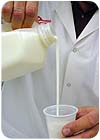
Henry Randolph
205/595-6455
HERConsult@aol.com
205/595-6455
HERConsult@aol.com
Ropy milk is not widely recognized as a serious quality problem by many modern-day academics and dairy plant operators. Thus, it is often ignored until the defect shows up as a customer complaint. This defect is given serious discussion in all dairy textbooks published before 1960. It is either not discussed as a serious problem or not mentioned at all in dairy textbooks published in the last 15 years. Since the organisms that cause ropy milk have always been with us, it would be logical to question why it went from being a common problem to being overlooked and why it is a serious problem in 2006. The logical explanation for the decline in the incidence of ropy milk between 1950 - 1970 would be improved sanitation and cooling on farms and in plants. An explanation for its emerging significance during the past 15 years is the widespread trend to larger dairy farms, transporting raw milk long distances, and the quest for extended shelf life in HTST pasteurized fluid milk products.

Figure 1.
Causes: Ropiness is caused by gums or mucins formed by bacteria. These materials are closely related to the capsule or gelatinous membrane that surrounds the cells of some bacteria. Two common organisms that cause ropiness areAlcaligenes viscolactis(viscous) andEnterobacter aerogenes. Other known causes are strains ofKlebisella, BacillusandPseudomonas. Some micrococci and strains of lactic bacteria (Lactobacillus, Leuconostoc, PediococcusandStreptococcus) may also cause ropiness.
Sources of Contamination: Organisms responsible for ropy milk are usually picked up from improperly cleaned and sanitized udders and teats, contaminated water, feed or improperly cleaned and sanitized equipment including raw milk tanks, pumps, and tankers.
Testing for Ropy Milk: Unfortunately, there is not a modern-day scientific method for detecting the presence of "ropy" organisms in milk. Thus, industry must rely on a simple test that has been utilized for more than 50 years. This test involves incubating a small sample of milk at temperatures of 60 - 72°F for 24 to 36 hours and testing for ropiness by inserting a wooden pick into the milk and looking for the stringy condition of ropy or gently pouring from the vial looking for strands of rope or slime (Figure 1).
Control: Conditions that favor the growth and multiplication of bacteria (slow cooling and/or temperature abuse) magnify the problem. Most of the organisms that cause ropiness are Gram negative and destroyed by pasteurization. However, these organisms can circumvent the pasteurizer through splashes of raw milk and contribute to environmental contamination. Ropiness in pasteurized milk is sometimes not observed because the milk is consumed before sufficient bacterial growth has taken place to cause the defect. Many of the organisms that cause this condition are psychrotrophic and grow slowly at refrigerated temperatures. Some species ofBacillusare psychrotrophic spore formers that survive pasteurization and cause ropiness, while other species cause spoilage during extended refrigerated storage. Once "seeded" in a plant, these organisms pose a serious threat to the quality of products produced. Rigorous cleaning/sanitizing procedures are required for their removal. The presence of ropiness in test products demands a thorough review of sanitation practices from the farm through the plant.
Join Dr. Randolph and Associates for an Advanced Sanitation and Quality Workshop November 14 - 16, 2006. For registration information, contact Kristy Clark 205/595-6455 or kmclark@randolphconsulting.com.
